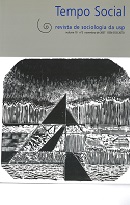Goffman's sociolinguistics and the mediated communication
DOI:
https://doi.org/10.1590/S0103-20702007000200010Keywords:
Conversation Analysis, Goffman, Frame Analysis, Sociolinguistics, Computer-Mediated CommunicationAbstract
The influence of the relationship between language and society on the methodology of the social sciences is well-known, beginning with the analyses of primitive forms of classification proposed by Mauss and Durkheim, and extending to the theories of discourse found in Ricoeur or Habermas. Less popular are sociolinguistic approaches that focus on the relation between forms of speech and social life, rooted in the linguistic relativism of Sapir-Whorf, Wittgenstein's linguistic pragmatics and Austin's Speech Act Theory. The aim of this article is to reconstruct a number of linguistic approaches to the analysis of mediated communication, highlighting Goffman's Frame Theory - artifices that frame interpretation and simultaneously comprise its necessary conditions for existence. The article closes with a case study, examining the possibility of applying Frame Theory to the analysis of e-mail as a form of computer-mediated communication.Downloads
References
BATESON, Gregory. (2002), “Uma teoria sobre brincadeira e fantasia”. In: RIBEIRO, Branca Telles & GARCEZ, Pedro M. (orgs.). Sociolingüística interacional. 2 ed. São Paulo, Loyola, pp. 257-264.
BERNSTEIN, Basil. (1971-75), Class, codes and control. Londres, Rootledge & Kegan Paul.
BODEN, Deirdre. (1990), “People are talking: conversation analysis and symbolic interaction”. In: MCCALL, Michal M. & BECKER, Howard S. Symbolic interactionism and cultural studies. Chicago, University of Chicago, pp. 244-274.
CHANDLER, Daniel. (1998), “Personal home pages and the construction of identities on the web”. Site http://www.aber.ac.uk/media/Documents/short/webident.htm, consultado em 21/8/2004.
CHAPMAN, David. (1992), “Computer rules, conversational rules”. Computational Linguistics, 18 (4): 531-535.
DOUGLAS, Mary. (1978), Símbolos naturales: exploraciones en cosmología. Madri, Alianza.
ECO, Umberto. (1991), Semiótica e filosofia da linguagem. São Paulo, Ática.
GADAMER, Hans-Georg. (1989), Truth and method. 2 ed. Nova York, Continuum.
GARCEZ, Pedro M. & OSTERMANN, Ana Cristina. (2002), “Glossário conciso da sociolingüística interacional”. In: RIBEIRO, Branca Telles & GARCEZ, Pedro M. (orgs.). Sociolingüística interacional. 2 ed. São Paulo, Loyola, pp. 257-264.
GEERTZ, Clifford. (1978), A interpretação das culturas. Rio de Janeiro, Zahar.
GOFFMAN, Erving. (1967), Interaction ritual: essays on face-to-face behavior. Nova York, Pantheon Books.
GOFFMAN, Erving. (1971), Relations in public: microstudies of the public order. Nova York, Basic Books.
GOFFMAN, Erving. (1974), Frame analysis. Nova York, Harper & Row.
GOFFMAN, Erving. (1981), Forms of talk. Filadélfia, University of Pennsylvania.
GOFFMAN, Erving. (1996), A representação do eu na vida cotidiana. Petrópolis, Vozes [1ª edição 1959: The presentation of self in everyday life. Nova York, Double Day].
GOFFMAN, Erving. (2002a), “A situação negligenciada”. In: RIBEIRO, Branca Telles & GARCEZ, Pedro M. (orgs.). Sociolingüística interacional. 2 ed. São Paulo, Loyola, pp. 13-20.
GOFFMAN, Erving. (2002b), Footing. In: RIBEIRO, Branca Telles & GARCEZ, Pedro M. (orgs.). Sociolingüística interacional. 2 ed. São Paulo, Loyola, pp. 107-148.
GUMPERZ, John J. (2002), “Convenções de contextualização”. In: RIBEIRO, Branca Telles & GARCEZ, Pedro M. (orgs.). Sociolingüística interacional. 2 ed. São Paulo, Loyola, pp. 149-182.
HARRISON, Bernard. (1980), An introduction to the philosophy of language. Nova York, Saint Martin.
HYMES, Dell. (1974), Foundations in sociolinguistics: an ethnographic approach. Filadélfia, University of Pensylvania.
JEFFERSON, G. A, SACKS, Harvey & SCHEGLOFF, E. (1974), “The simplest systematics for the organization of turn-taking in conversation”. Language, 50: 696-735.
JONES, Rodney H. (2002), “The problem of context in computer mediated communication”. Paper presented at Georgetown Roundtable on Language and Linguistics, 7-9 de março. Site http://personal.cityu.edu.hk/~enrodney/Research/ContextCMC.doc, consultado em 21/8/2004.
MÁXIMO, Maria Elisa. (2002), “Sociabilidade no ‘ciberespaço’: uma análise da dinâmica de interação na lista eletrônica de discussão Cibercultura”. Trabalho apresentado no XXVI Encontro Anual da Anpocs.
MCWILLIAMS, Elizabeth Mindy. (2001), Social and organizations frames: a discourse analysis of e-mail sent at work. Washington. Dissertação de mestrado.
MILLER, Hugh. (1995), “The presentation of self in electronic life: Goffman on the Internet”. Site http://ess.ntu.ac.uk/miller/cyberpsych/goffman.htm, consultado em 21/8/2004.
NUNES, Jordão Horta. (2005), Interacionismo simbólico e dramaturgia: a sociologia de Goffman. São Paulo/Goiânia, Humanitas/Editora da UFG.
PITKIN, Hanna Fenichel. (1972), Wittgenstein and justice. Berkeley, University of California.
RIBEIRO, Branca Telles & GARCEZ, Pedro M. (orgs.). Sociolingüística interacional. 2 ed. São Paulo, Loyola.
RYLE, Gilbert. (1971), “The thinking of thoughts: what is ‘le penseur’ doing?”. In: Collected Papers, vol. 2. Londres, Hutchinson.
SANNICOLAS, Nikki. (1997), “Erving Goffman, dramaturgy and on-line relationships”. Cibersociology. Site http://www.cybersoc.com/magazine/1/is1nikki.html, consultado em 29/8/2004.
SCHEGLOFF, Emanuel A. (1968), “Sequencing in conversational openings”. American Anthropologis, 6 (70): 1075-1095, dez.
SCHEGLOFF, Emanuel A. (1986), “The routine as achievement”. Human Studies, 2/3 (9): 111-151.
SCHEGLOFF, E. & SACKS, H. (1973), “Opening up closings”. Semiotica, 8: 289-237.
SCOLLON, R. et al. (1999), “Blurred genres and fuzzy identities in Hong Kong public discourse: foundational ethnographic issues in the study of reading”. Applied Linguistics, 1 (20): 22-43.
TANNEN, D. (1993). “What’s in a frame?”. In: TANNEN, D. (ed.). Framing in discourse. Nova York, Oxford University, pp. 14-56.
WALKER, J. (2003), “Weblog”, Definition for the Routledge Encyclopedia of Narrative Theory. Site http://huminf.uib.no/~jill/archives/blog_theorising/final_version_of_weblog_definition.html, consultado em 21/8/2004.
Downloads
Published
Issue
Section
License
Copyright (c) 2015 Tempo Social

This work is licensed under a Creative Commons Attribution-NonCommercial 4.0 International License.


